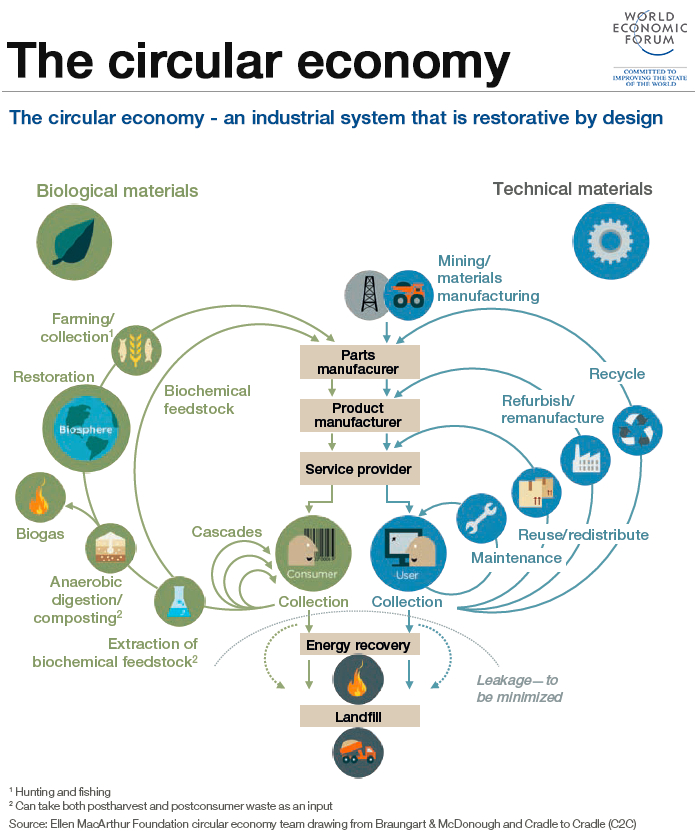
The average car lies idle for 90% of the day. The average power drill is used for 30 minutes of its entire life. Landfill dumps are full.
It is widely recognized that wasteful exploitation of the world’s resources is taking its toll on the environment, but it is less appreciated that the rate and nature of our consumption is choking economic growth. As much as $25 trillion could be at stake by 2050 unless we change the relationship between natural resources, customers and the market. Thanks to radical new business models and technologies, some companies are now growing by finding value in resources, assets and products that have, until now, been vastly underutilised. The circular economy is starting to turn, but more efforts are needed if we are to decouple economic growth from increasing use of natural resources.
For forty years until the turn of the millennium, business got used to commodity prices decreasing as growth surged. But this pattern then reversed dramatically, as the rise of urban populations and middle class consumption led to intense shortages of many resources while putting others such as water and fertile soil under great stress. In recent years, prices have skyrocketed and crashed dramatically. Businesses now feel the pain of unpredictable resource supplies and price volatility.
As a result of wasteful practices, prices for metals like copper, iron, tin and nickel, have nearly doubled between 2000 and 2015. The real price of oil in August 2015 was still 55% higher than in August 2000. Businesses will respond by cutting margins, passing on the costs to customers as well as through efficiencies and innovations like shale gas. But even with those responses taken into account, our ‘take, make, waste’ linear model is on track to result in a shortfall of 8 billion tons in constrained resources by 2030. That translates to $4.5 trillion of lost growth, or as much as the U.S. consumes in a single year.
The circular economy is about more than recycling and managing landfill. Indeed that is a limited, one dimensional view of waste. We need to look at all four dimensions of waste as an opportunity. Find value in wasted resources that could become renewable, such as biofuel. Exploit the wasted capacity in property or assets that could find a market, such as the 60% of Europe’s truck capacity that remains empty most of the time. Reduce the wasted lifecycles that currently see products discarded rather than refurbished, often because they are not built to last or are designed for early obsolescence. Finally, secure the wasted embedded values by finding uses for otherwise rejected materials.
The linear economy has baked in ways of accommodating waste and insufficiently valuing waste, making it harder to change course. Circular business models demand major changes in mindset, organization and strategy to implement them at scale. Caterpillar Inc. saves itself and its customers considerable money and up to 90% of energy use by remanufacturing millions of components each year in a profitable operation employing more than 4,000 people.
But it is no surprise that many of the pioneers successfully enjoying a circular advantage are independent start-ups free of the legacy linear thinking. This is particularly visible in the sharing economy, where brands like Airbnb and Uber match supply and demand to use spare capacity of existing assets.
But traditional companies are also exploring radical strategies. Some are transforming themselves from product into service providers, offering mobility or uptime instead of trucks or machines. That requires shifting from selling to owning and servicing assets, which in turn encourages companies to design greater reliability and longevity into products. For example, Philips is selling ‘lighting as a service’, charging customers not for LED diodes but for their usage, creating new customer value.
Perhaps the most challenging circular business models are those that transform the supply chain, extend the life of products or re-use waste and materials in new ways. Take vertical urban farming that stacks plants, hydrates with mist and uses LED lighting to boost yields with a fraction of the space and resources required in traditional farming. This demands very different design, processes and interactions with suppliers and customers. But the rewards can be significant. Not only do they lower costs and drive extreme resource productivity, they improve the predictability of the supply chain that many companies have seen slip beyond their control. And they help differentiate brands and products.
Many of these circular approaches depend on new technologies – from materials science to mobile, cloud computing and data analytics. Indeed the ability to harness data to manage resources through value chains is at the heart of some of the most successful circular business models.
If companies are making progress, they are still not close to making the circular economy mainstream. Governments are becoming more active in penalizing waste, reducing fuel subsidies and implementing environmental standards. But more policy intervention is required to bring transparency to the content of products and to reward the repurposing of materials. Above all, governments need to stand back and recognize that the circular economy needs to be put on an equal footing with today’s linear economy.
The negative environmental impact of industrial activity is now being taken seriously. But the positive economic impact of the circular economy provides a more appealing way to incentivize responsible use of resources by businesses. Let it flourish and a $25 trillion dollar opportunity will be there for the taking.



